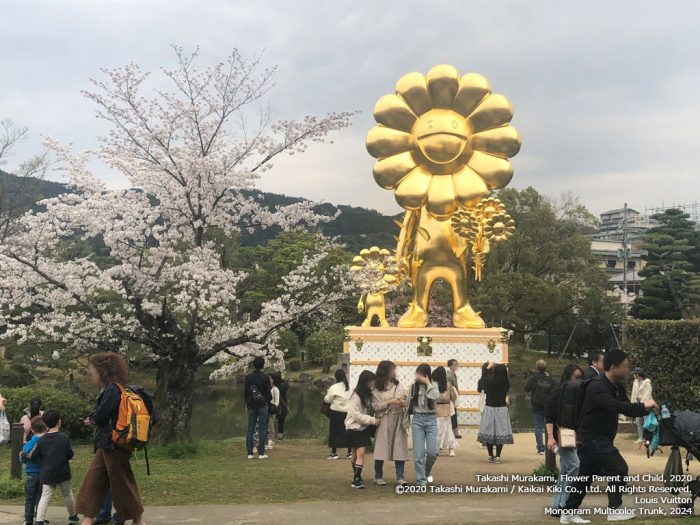COMMUNICATIONS
Kyoto in 2.5D
In 2000, Takashi Murakami declared in The Super Flat Manifesto that, “The world of the future might be like Japan is today – super flat.” Since then, visions of the future offered by artists have oscillated between high-tech projections like Murakami’s bold anticipation, and catastrophist apocalyptic visions driven by the experiences of 11 March 2011 and the COVID pandemic, all against the backdrop of the climate crisis.
My research stay at Nichibunken examining contemporary Japanese art has happily coincided with Takashi Murakami’s major exhibition in Kyoto, Takashi Murakami Mononoke Kyoto. Murakami opened the monumental exhibition held at the Kyoto City KYOCERA Museum of Art in early 2024 *1.
Visitors will find hopes for renewal pervading the exhibition. Welcoming us are the red and blue giants of Embodiment of ‘A’ and Embodiment of ‘Um’, originally designed to protect us after the disaster of 11 March, while the large mural of pink sakura flowers invokes the natural rebirth of spring. Rather than a return to triumphant superflatness, however, this 2024 exhibition instead introduces new reserves of anger, with protest bubbling in the background. Punctuating the exhibition with comic-book bubbles allows Murakami to address visitors directly, and in doing so deconstruct its superflat surface.
The bubbles, like clouds in Rakuchū-Rakugai-zu Byōbu : Iwasa Matabei RIP *2, evoke another dimension and are reminiscent of two-dimensional cartographic representations. Through these bubbles, Murakami apologizes for the fact that the paintings are not finished, that the retail space constitutes 1/5 of the exhibition, that there was no budget, and that everything was done in haste. He also goes into details about how the exhibition was financed, and offers his reflections on taxes, his sponsors and his gallery owners. Along the way, Murakami jabs at everyone, and thus scores the surface of the exhibition with his irony.
The exhibition is in many ways the pinnacle of superflat, bringing together traditional Kyoto art and pop art, and transforming the classical city of Kyoto into a world populated by Murakami’s creatures. It simultaneously reveals the notion’s limits, however, as on the threshold of the exhibition, the speech bubbles written by Murakami reveal its aporias. The bubbles point to the presence of something beyond the superflat, expanding out from its 2D portrayal to provide evidence for contestation and engagement, rather than merely accentuating the infantilization which Murakami lays claim to. The background to the exhibition, its context, and its multiple meanings are seared into its shiny surface. Murakami’s obvious dissatisfaction lurks behind the acid colors, creating a sense of vibration, of the trembling of the flat. Pop is no longer triumphant, but self-financed, self-subsidized, camouflaged, underground, and pirate.
The result is a middle ground being worked out between high-tech futures and impending catastrophes, a future for art in the background, underground.
I’m so happy to be here for this springtime of Japanese contemporary art – in 2.5D.

View of the exhibition, in Spring
*1 Kyoto City Museum of Art 90th Anniversary Exhibition: Takashi Murakami Mononoke Kyoto, held at the Kyoto City KYOCERA Museum of Art (2024/2/3–2024/9/1)
*2 The exhibition displays a thirteen-meter-long contemporary Rakuchū Rakugai Zu 洛中洛外図, Murakami’s homage to Iwasa Matabei’s celebrated seventeenth-century screen depicting Scenes in and around Kyoto (Funaki Version).




